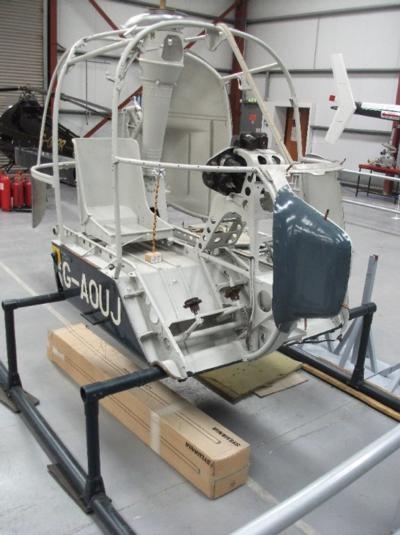Aircraft Has Had A Long Journey, And Still Has A Long Way To go
The Helicopter Museum (THM), located in Weston-super-Mare, Somerset, UK, has successfully secured two grants totalling just over £14,000 (approx $23,500) from the Arts Council PRISM Fund to complete the restoration of its Fairey Ultra Light helicopter GAOUJ originally built in 1956 and rediscovered in an Essex farmyard by THM founder Elfan ap Rees in 1978.

Following a period in storage, some preliminary work on restoration was carried out by the Cotswold Restoration Group (CRG) but had to be abandoned and the airframe returned to the museum in November 2010. Here a new four man (and one occasional woman) Volunteer Team, led by John Derrick was formed in March 2011, beginning immediately with a survey of the whole project and then restoration of the fuselage box structure. This showed signs of serious corrosion and needed careful treatment before the application of etch primer to areas of bare metal followed by a new coat of carefully matched paint.
By the end of that summer, the team had completed this work and were able to refit the restored skid landing gear and several other refurbished components, including the pilot’s seat, rotorhead pylon and the instrument panel housing. A search for the previously restored instrument panel itself at the museum proved the value of keeping records, revealing that the unit had not returned from CRG. Fortunately it turned up in a former member’s garage unrecognized and forgotten but soon recovered and restored in the cockpit. The initial work on the main fuselage was now followed by the restoration of the tailboom and stainless steel rudder unit which by May 2012, was complete and ready for attaching to the fuselage.
At this point the team was faced with having to begin manufacturing missing parts in-house. Unfortunately a number of small components were lost while many other small parts had returned from CRG in miscellaneous tins etc. with no identifying labels or other means of recognition. Other parts of course had been removed for spares recovery when ‘UJ’ was originally retired at the end of 1958.
Fortunately sister ship G-APJJ survives more or less intact at the Midland Air Museum and the team has made several visits to identify, measure and photograph parts for replication. This included the missing H tail unit, which has since been replicated by apprentices at the Vector Aerospace, Fleetlands facility and delivered back to the Museum for painting and installation. Manufacturing in-house included a replica main rotor head and many smaller components.
Meanwhile a Turbomeca Palouste engine stored at the Museum was refurbished in late 2012 by the Rolls Royce Heritage Trust branch in Bristol, with modified connections to suit the Ultra Light mountings. A replacement collective lever was the next prize, donated by the Midland Air Museum.
With ownership of the helicopter now officially transferred to THM, the next major challenge to be tackled is the manufacture of replacement cockpit glazings and the replacement of a multicurvature fuselage panel at the rear of the cabin which is another missing part. A substantial part of the PRISM grant aid is allocated to these works, with the glazings being manufactured commercially and the fuselage panel being built in house. With typical ingenuity the team has made a mold to replicate the latter in fibreglass. Various other detailed parts that need to be replicated will also be manufactured in the museum’s workshop with material costs covered by the grants.
THM Restoration Manager Rod Holloway says “We are immensely grateful to the PRISM Fund for recognizing the value of restoring the Ultra Light to a display condition. The funding will allow us to accelerate completion of the project and we now hope this example of early tip-jet helicopter technology will be ready to take its place in the THM line up of rare prototypes by Spring 2015.
(Image provided by The Helicopter Museum)
 ANN's Daily Aero-Term (04.26.24): DETRESFA (Distress Phrase)
ANN's Daily Aero-Term (04.26.24): DETRESFA (Distress Phrase) ANN's Daily Aero-Linx (04.26.24)
ANN's Daily Aero-Linx (04.26.24) Airborne 04.22.24: Rotor X Worsens, Airport Fees 4 FNB?, USMC Drone Pilot
Airborne 04.22.24: Rotor X Worsens, Airport Fees 4 FNB?, USMC Drone Pilot Airborne 04.24.24: INTEGRAL E, Elixir USA, M700 RVSM
Airborne 04.24.24: INTEGRAL E, Elixir USA, M700 RVSM Airborne-NextGen 04.23.24: UAVOS UVH 170, magni650 Engine, World eVTOL Directory
Airborne-NextGen 04.23.24: UAVOS UVH 170, magni650 Engine, World eVTOL Directory



